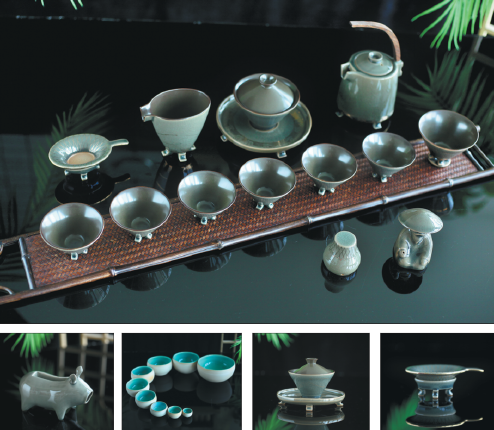Firing up a passion for ceramics
Craftsman's colored glaze products combine innovation and history, Li Yingxue reports.

Xin Zhaoguo felt a sense of nervous anticipation as he prepared to open the kiln. Just one day earlier, he had carefully placed 200 cups inside and fired them for a full 10 hours.
Now, after allowing the interior to cool, it was finally time to reveal the results.
He couldn't help but feel excited at the prospect of seeing his new creations.
It was this element of surprise that made Xin's work more rewarding. "That is the special thing about colored glaze — you will never know if you have been successful or not until you open the kiln," Xin explains.
"The charm of colored glaze is in its unpredictability, with each piece taking on a unique pattern and hue that can never be replicated," he says.
Xin, 48, is an inheritor of Zibo-style colored glaze, an intangible cultural heritage of the city in Shandong province. It's a traditional Chinese ceramic craft which is renowned for its unique and vibrant colors.
Originating in the Song Dynasty (960-1279), colored glaze has become an important calling card for folk art in Zibo. It was popular in the 1980s and the '90s and products were sold to overseas markets. However, in the past two decades, fewer people have continued engaging in the handicraft, as it is not easy to make a living.
With more than three decades of experience in this field, Xin has won multiple prizes with his unique colored glaze creations. He is designing more new products to explore greater possibilities of this traditional Chinese skill, as well as trying to spark the interest of younger customers.
Together with his wife Zhao Zengxia, Xin is also gathering other local intangible cultural heritage inheritors in Zibo to better preserve these traditional skills through research, communication and collaboration.
Born in Zibo, Xin was introduced to ceramics at a young age due to his family's involvement with the traditional craft. His father, uncles and grandfather were all renowned color glaze masters, and he learned his skills from them.
Xin remembers watching his father and uncles making pottery every day, and observing in amazement that a lump of clay could transform into vessels of different shapes in their hands, as if by magic.
Driven by this curiosity, Xin developed a strong interest in clay. With his keen eye, Xin learned the pottery making techniques by observing and assisting his family with tasks such as trimming, glazing and firing.
The process of creating the Zibo-style pottery involves applying various colored glazes onto the surface of the ceramic during production, which are then fired at high temperatures to create an artistic effect.
Creating surprises
He was amazed by the transformation that occurred during the firing process, where pieces of the same color that went into the kiln would emerge with an array of different shades.
However, as the years passed, Xin lost interest in clay and went to work in a mechanical factory for three months, during which time, his hands, once accustomed to working with clay, touched hard, unyielding metal.
He soon realized that, unlike being a lathe operator, which requires following strict rules, his passion lay in more creative pursuits.
From then on, he has been practicing making colored glaze. "My fingerprints have been worn off, so I can't use them for fingerprint recognition or opening my electronic lock. My hands are no longer responsive to these tasks," Xin says.
One of Xin's signature designs is his Ruoque (meaning "as if defective") cup, which has won him numerous awards. At first glance, the vessel looks roughly produced, but it's actually made with a delicate touch.
According to Xin, the cup is inspired by the Taoist work, Tao Te Ching, and he believes that truly great achievement does not come from perfection.
The origin of the design comes from a cup he once made that cracked, and it looked like the bark of an old tree. Xin, inspired, after numerous attempts, finally created the Ruoque cup. It is made from rough clay with fine craftsmanship. Although its exterior appears utilitarian, the rim, bottom and inside of the cup are crafted with exquisite detail.
"I used a combination of clay and other special materials to create a chemical reaction that resulted in an irregular pattern of cracked glaze," Xin explains.
"When you drink tea from the cup, you won't feel any scratches or roughness, and the handle of the cup will also become smoother with use," Xin says.
His Yuanrong (meaning "harmony") cup is another of his signature items. The smooth, round, bulbous-shaped cup has no support at its bottom, but cannot be knocked over.
According to Xin, the meaning behind the design is to encourage people to be flexible and adaptable, and to not be stubborn.
One of Xin's works features a white-goat pattern that emerged naturally during firing. Xin explains that this is the uniqueness of color glaze, which often brings unexpected surprises. "You will never make another with the same pattern," he says.
Onward together
Zhao and Xin were classmates in junior middle school. They fell in love and have been together for about 30 years.
Zhao, born in 1977 to a family with a ceramic business in Zibo, remembers that she used to help her parents in their ceramic stores with her elder brother. She took over the family business at the age of 18.
Zhao recalls that, in the 1990s, ceramics were mass-produced and one batch could contain tens of thousands of tea sets.
That trend has changed, she says, noting that people no longer require their ceramics to be functional.
"Customers, especially younger ones, have high requirements for porcelain, and many people insist that the design has to be both attractive and interesting," Zhao says.
In 2013, Zhao and Xin established Zhaoxia Ceramics, to make cultural and creative ceramic products designed by themselves.
Zhao recalls that the past decade, experiencing the ups and downs of entrepreneurship, has been hard, yet worth it.
"The development of the ceramic business over recent decades is like a miniature version of society in China," Zhao says. "It's now an era that is led by the customers."
They also collaborate with young designers to create new products. "With our 30 years of experience, we can help them to make their designs a reality," Zhao says.
As well as the series of products that are all handmade by Xin, Zhao says that their studio also launches two sets of cultural and creative products each year. This year, they are designing presents to celebrate four key moments in life, including marriage and enrollment into a prestigious school.
Xin pays great attention to the inheritance and promotion of the special techniques required to make Zibo-style color glaze. He also actively participates in various cultural activities and exhibitions and guides apprentices in his own studio.
On many visits to Jingdezhen in Jiangxi province, China's porcelain capital, Xin met with local craftsmen. Xin thinks that, as inheritors, they should combine traditional craftsmanship with digital technology to better pass down their skills.
Under the title of "Master Xin's studio", Xin livestreams on short-video platform Douyin every afternoon between 2 pm and 4 pm. He is surprised that there are thousands of people watching him making porcelain, and he enjoys answering their questions. Some fans even visit his studio to learn from him in person after watching his videos.
The couple also invites scholars, design teams and professionals from across the country to their studio to discuss how to further popularize glaze culture.
Xin and Zhao have also established a handicraft culture research institute in Zibo to gather together the city's craftsmen. "We want to be their agent, helping produce and sell their craft works, which is a way of helping to pass on these skills," Zhao says.




Today's Top News
- Restoring truth is the least we can do to serve history
- Israeli airstrikes hit Gaza amid worsening humanitarian crisis
- Book on Confucianism launched in Brussels
- Right track for China-ROK ties lauded
- Nursery rooms help fathers take part in parenting duties with more ease
- Typhoon Kajiki brings heavy rain in Hainan






























